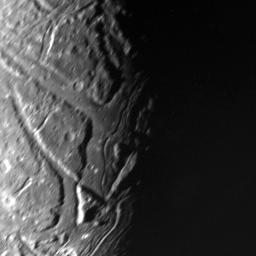
|
Ariel’s Transecting Valleys
- Click the image above for a larger view
- Full-Res JPEG (512 x 512) (27.4 kB)
- Full-Res TIFF (512 x 512) (140.5 kB)
Caption:
This highest-resolution Voyager 2 view of Ariel's terminator shows a complex array of transecting valleys with super-imposed impact craters. Voyager obtained this clear-filter, narrow-angle view from a distance of 130,000 kilometers (80,000 miles) and with a resolution of about 2.4 km (1.5 mi). Particularly striking to Voyager scientists is the fact that the faults that bound the linear valleys are not visible where they transect one another across the valleys. Apparently these valleys were filled with deposits sometime after they were formed by tectonic processes, leaving them flat and smooth. Sinuous rilles (trenches) later formed, probably by some flow process. Some type of fluid flow may well have been involved in their evolution.
Background Info:
The Voyager project is managed for NASA by the Jet Propulsion Laboratory.
Cataloging Keywords:
| Name | Value | Additional Values |
|---|---|---|
| Target | Ariel | |
| System | Uranus | |
| Target Type | Satellite | |
| Mission | Voyager | |
| Instrument Host | Cassini Orbiter | Voyager 2 |
| Host Type | Orbiter | Flyby Spacecraft |
| Instrument | Imaging Science Subsystem (ISS) | |
| Detector | Narrow Angle Camera | |
| Extra Keywords | Crater, Grayscale, Impact, Visual | |
| Acquisition Date | ||
| Release Date | 1998-12-05 | |
| Date in Caption | ||
| Image Credit | NASA/JPL | |
| Source | photojournal.jpl.nasa.gov/catalog/PIA01356 | |
| Identifier | PIA01356 | |
